Yoon Kim
Richard
reWordBench: Benchmarking and Improving the Robustness of Reward Models with Transformed Inputs
Mar 14, 2025Abstract:Reward models have become a staple in modern NLP, serving as not only a scalable text evaluator, but also an indispensable component in many alignment recipes and inference-time algorithms. However, while recent reward models increase performance on standard benchmarks, this may partly be due to overfitting effects, which would confound an understanding of their true capability. In this work, we scrutinize the robustness of reward models and the extent of such overfitting. We build **reWordBench**, which systematically transforms reward model inputs in meaning- or ranking-preserving ways. We show that state-of-the-art reward models suffer from substantial performance degradation even with minor input transformations, sometimes dropping to significantly below-random accuracy, suggesting brittleness. To improve reward model robustness, we propose to explicitly train them to assign similar scores to paraphrases, and find that this approach also improves robustness to other distinct kinds of transformations. For example, our robust reward model reduces such degradation by roughly half for the Chat Hard subset in RewardBench. Furthermore, when used in alignment, our robust reward models demonstrate better utility and lead to higher-quality outputs, winning in up to 59% of instances against a standardly trained RM.
On the Duality between Gradient Transformations and Adapters
Feb 19, 2025Abstract:We study memory-efficient optimization of neural networks with linear gradient transformations, where the gradients are linearly mapped to a lower dimensional space than the full parameter space, thus saving memory required for gradient accumulation and optimizer state persistence. The model parameters are updated by first performing an optimization step in the lower dimensional space and then going back into the original parameter space via the linear map's transpose. We show that optimizing the model in this transformed space is equivalent to reparameterizing the original model through a linear adapter that additively modifies the model parameters, and then only optimizing the adapter's parameters. When the transformation is Kronecker-factored, this establishes an equivalence between GaLore and one-sided LoRA. We show that this duality between gradient transformations and adapter-based reparameterizations unifies existing approaches to memory-efficient training and suggests new techniques for improving training efficiency and memory use.
Vision-Language Models Do Not Understand Negation
Jan 16, 2025



Abstract:Many practical vision-language applications require models that understand negation, e.g., when using natural language to retrieve images which contain certain objects but not others. Despite advancements in vision-language models (VLMs) through large-scale training, their ability to comprehend negation remains underexplored. This study addresses the question: how well do current VLMs understand negation? We introduce NegBench, a new benchmark designed to evaluate negation understanding across 18 task variations and 79k examples spanning image, video, and medical datasets. The benchmark consists of two core tasks designed to evaluate negation understanding in diverse multimodal settings: Retrieval with Negation and Multiple Choice Questions with Negated Captions. Our evaluation reveals that modern VLMs struggle significantly with negation, often performing at chance level. To address these shortcomings, we explore a data-centric approach wherein we finetune CLIP models on large-scale synthetic datasets containing millions of negated captions. We show that this approach can result in a 10% increase in recall on negated queries and a 40% boost in accuracy on multiple-choice questions with negated captions.
Ladder-residual: parallelism-aware architecture for accelerating large model inference with communication overlapping
Jan 11, 2025



Abstract:Large language model inference is both memory-intensive and time-consuming, often requiring distributed algorithms to efficiently scale. Various model parallelism strategies are used in multi-gpu training and inference to partition computation across multiple devices, reducing memory load and computation time. However, using model parallelism necessitates communication of information between GPUs, which has been a major bottleneck and limits the gains obtained by scaling up the number of devices. We introduce Ladder Residual, a simple architectural modification applicable to all residual-based models that enables straightforward overlapping that effectively hides the latency of communication. Our insight is that in addition to systems optimization, one can also redesign the model architecture to decouple communication from computation. While Ladder Residual can allow communication-computation decoupling in conventional parallelism patterns, we focus on Tensor Parallelism in this paper, which is particularly bottlenecked by its heavy communication. For a Transformer model with 70B parameters, applying Ladder Residual to all its layers can achieve 30% end-to-end wall clock speed up at inference time with TP sharding over 8 devices. We refer the resulting Transformer model as the Ladder Transformer. We train a 1B and 3B Ladder Transformer from scratch and observe comparable performance to a standard dense transformer baseline. We also show that it is possible to convert parts of the Llama-3.1 8B model to our Ladder Residual architecture with minimal accuracy degradation by only retraining for 3B tokens.
The Surprising Effectiveness of Test-Time Training for Abstract Reasoning
Nov 11, 2024
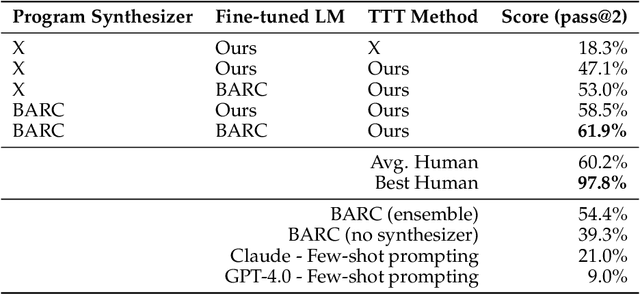
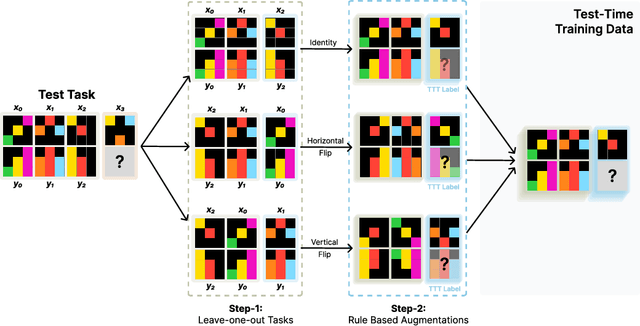
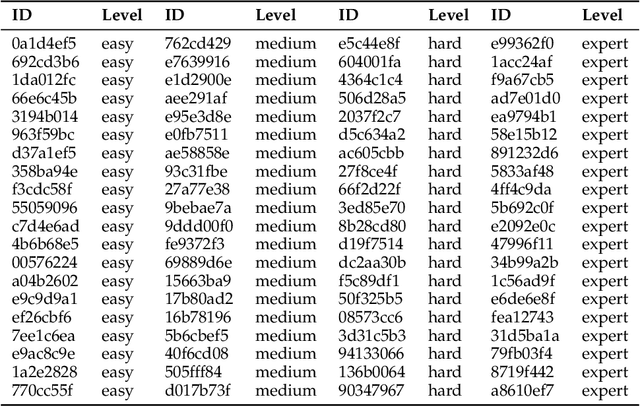
Abstract:Language models have shown impressive performance on tasks within their training distribution, but often struggle with novel problems requiring complex reasoning. We investigate the effectiveness of test-time training (TTT) -- updating model parameters temporarily during inference using a loss derived from input data -- as a mechanism for improving models' reasoning capabilities, using the Abstraction and Reasoning Corpus (ARC) as a benchmark. Through systematic experimentation, we identify three crucial components for successful TTT: (1) initial finetuning on similar tasks (2) auxiliary task format and augmentations (3) per-instance training. TTT significantly improves performance on ARC tasks, achieving up to 6x improvement in accuracy compared to base fine-tuned models; applying TTT to an 8B-parameter language model, we achieve 53% accuracy on the ARC's public validation set, improving the state-of-the-art by nearly 25% for public and purely neural approaches. By ensembling our method with recent program generation approaches, we get SoTA public validation accuracy of 61.9%, matching the average human score. Our findings suggest that explicit symbolic search is not the only path to improved abstract reasoning in neural language models; additional test-time applied to continued training on few-shot examples can also be extremely effective.
The Semantic Hub Hypothesis: Language Models Share Semantic Representations Across Languages and Modalities
Nov 07, 2024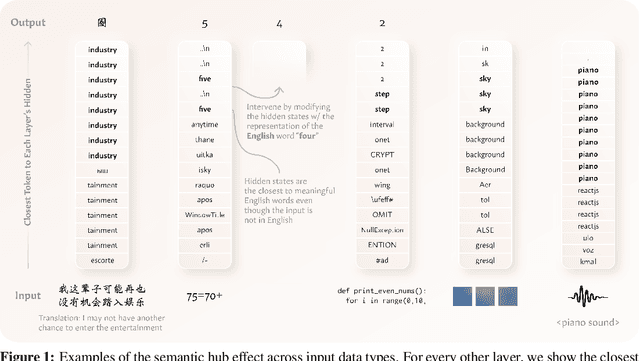
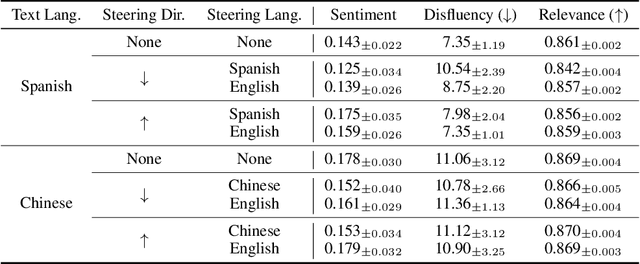
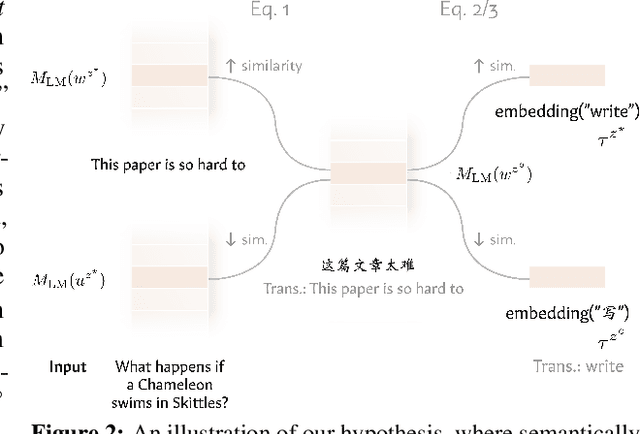
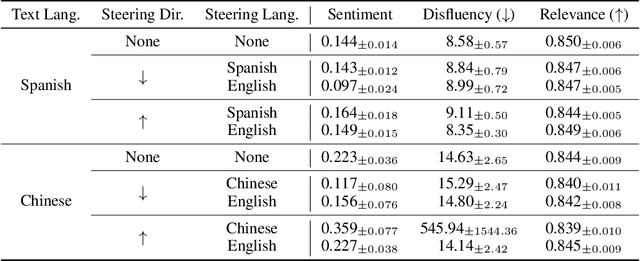
Abstract:Modern language models can process inputs across diverse languages and modalities. We hypothesize that models acquire this capability through learning a shared representation space across heterogeneous data types (e.g., different languages and modalities), which places semantically similar inputs near one another, even if they are from different modalities/languages. We term this the semantic hub hypothesis, following the hub-and-spoke model from neuroscience (Patterson et al., 2007) which posits that semantic knowledge in the human brain is organized through a transmodal semantic "hub" which integrates information from various modality-specific "spokes" regions. We first show that model representations for semantically equivalent inputs in different languages are similar in the intermediate layers, and that this space can be interpreted using the model's dominant pretraining language via the logit lens. This tendency extends to other data types, including arithmetic expressions, code, and visual/audio inputs. Interventions in the shared representation space in one data type also predictably affect model outputs in other data types, suggesting that this shared representations space is not simply a vestigial byproduct of large-scale training on broad data, but something that is actively utilized by the model during input processing.
Training-Free Activation Sparsity in Large Language Models
Aug 26, 2024Abstract:Activation sparsity can enable practical inference speedups in large language models (LLMs) by reducing the compute and memory-movement required for matrix multiplications during the forward pass. However, existing methods face limitations that inhibit widespread adoption. Some approaches are tailored towards older models with ReLU-based sparsity, while others require extensive continued pre-training on up to hundreds of billions of tokens. This paper describes TEAL, a simple training-free method that applies magnitude-based activation sparsity to hidden states throughout the entire model. TEAL achieves 40-50% model-wide sparsity with minimal performance degradation across Llama-2, Llama-3, and Mistral families, with sizes varying from 7B to 70B. We improve existing sparse kernels and demonstrate wall-clock decoding speed-ups of up to 1.53$\times$ and 1.8$\times$ at 40% and 50% model-wide sparsity. TEAL is compatible with weight quantization, enabling further efficiency gains.
LLM economicus? Mapping the Behavioral Biases of LLMs via Utility Theory
Aug 05, 2024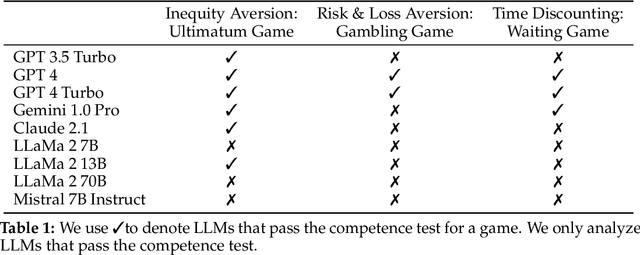

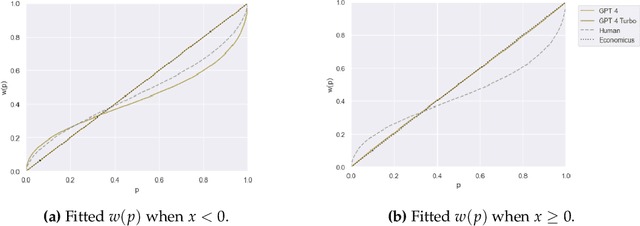
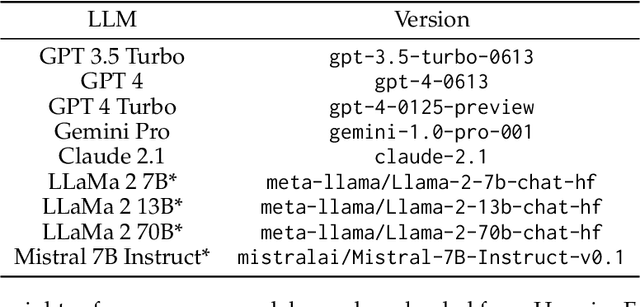
Abstract:Humans are not homo economicus (i.e., rational economic beings). As humans, we exhibit systematic behavioral biases such as loss aversion, anchoring, framing, etc., which lead us to make suboptimal economic decisions. Insofar as such biases may be embedded in text data on which large language models (LLMs) are trained, to what extent are LLMs prone to the same behavioral biases? Understanding these biases in LLMs is crucial for deploying LLMs to support human decision-making. We propose utility theory-a paradigm at the core of modern economic theory-as an approach to evaluate the economic biases of LLMs. Utility theory enables the quantification and comparison of economic behavior against benchmarks such as perfect rationality or human behavior. To demonstrate our approach, we quantify and compare the economic behavior of a variety of open- and closed-source LLMs. We find that the economic behavior of current LLMs is neither entirely human-like nor entirely economicus-like. We also find that most current LLMs struggle to maintain consistent economic behavior across settings. Finally, we illustrate how our approach can measure the effect of interventions such as prompting on economic biases.
Fast Matrix Multiplications for Lookup Table-Quantized LLMs
Jul 15, 2024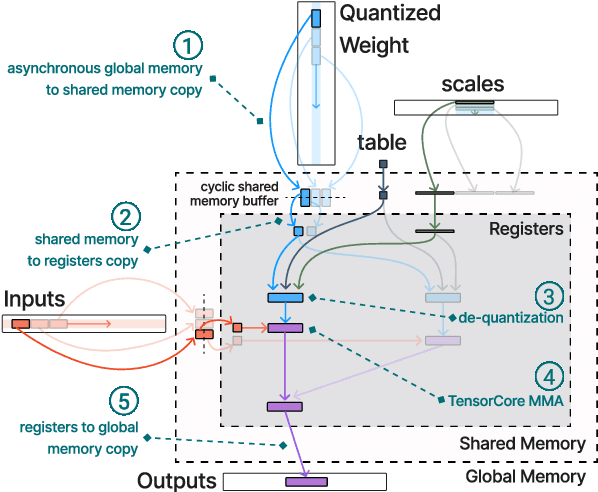
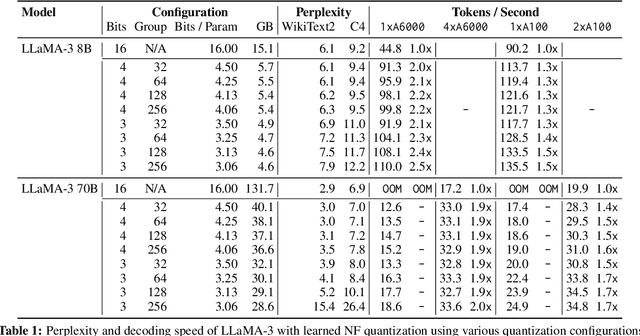

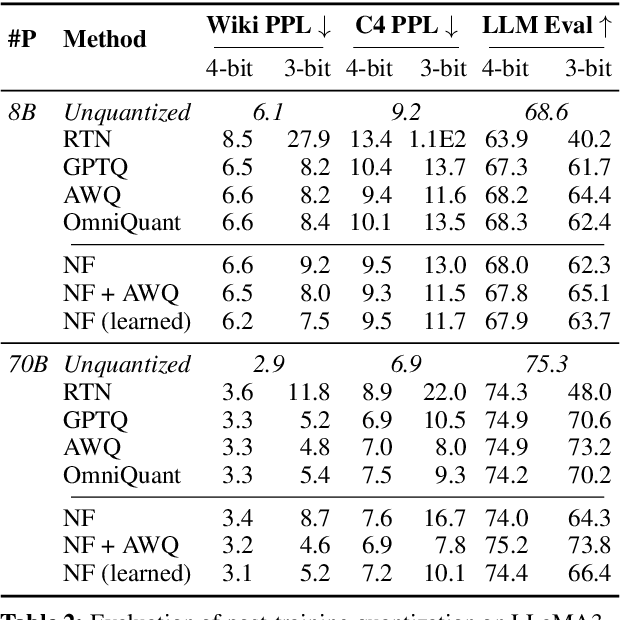
Abstract:The deployment of large language models (LLMs) is often constrained by memory bandwidth, where the primary bottleneck is the cost of transferring model parameters from the GPU's global memory to its registers. When coupled with custom kernels that fuse the dequantization and matmul operations, weight-only quantization can thus enable faster inference by reducing the amount of memory movement. However, developing high-performance kernels for weight-quantized LLMs presents substantial challenges, especially when the weights are compressed to non-evenly-divisible bit widths (e.g., 3 bits) with non-uniform, lookup table (LUT) quantization. This paper describes FLUTE, a flexible lookup table engine for LUT-quantized LLMs, which uses offline restructuring of the quantized weight matrix to minimize bit manipulations associated with unpacking, and vectorization and duplication of the lookup table to mitigate shared memory bandwidth constraints. At batch sizes < 32 and quantization group size of 128 (typical in LLM inference), the FLUTE kernel can be 2-4x faster than existing GEMM kernels. As an application of FLUTE, we explore a simple extension to lookup table-based NormalFloat quantization and apply it to quantize LLaMA3 to various configurations, obtaining competitive quantization performance against strong baselines while obtaining an end-to-end throughput increase of 1.5 to 2 times.
Lookback Lens: Detecting and Mitigating Contextual Hallucinations in Large Language Models Using Only Attention Maps
Jul 09, 2024Abstract:When asked to summarize articles or answer questions given a passage, large language models (LLMs) can hallucinate details and respond with unsubstantiated answers that are inaccurate with respect to the input context. This paper describes a simple approach for detecting such contextual hallucinations. We hypothesize that contextual hallucinations are related to the extent to which an LLM attends to information in the provided context versus its own generations. Based on this intuition, we propose a simple hallucination detection model whose input features are given by the ratio of attention weights on the context versus newly generated tokens (for each attention head). We find that a linear classifier based on these lookback ratio features is as effective as a richer detector that utilizes the entire hidden states of an LLM or a text-based entailment model. The lookback ratio-based detector -- Lookback Lens -- is found to transfer across tasks and even models, allowing a detector that is trained on a 7B model to be applied (without retraining) to a larger 13B model. We further apply this detector to mitigate contextual hallucinations, and find that a simple classifier-guided decoding approach is able to reduce the amount of hallucination, for example by 9.6% in the XSum summarization task.
 Add to Chrome
Add to Chrome Add to Firefox
Add to Firefox Add to Edge
Add to Edge